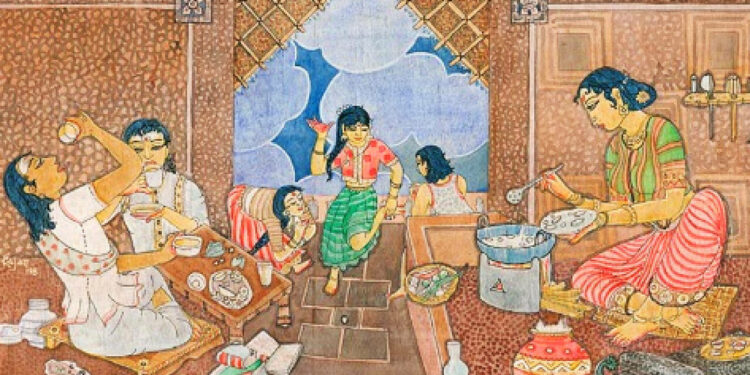The study of women’s history in the Indian subcontinent has been a major scholarly and popular field, with many scholarly books and articles, museum exhibits, and courses in schools and universities.
Women during the Vedic period enjoyed high status with men in all aspects of life. Works by ancient Indian grammarians such as Patanjali and Katyayana suggest that women were educated in the early Vedic period. Rig Vedic verses suggest that women married at a mature age and were probably free to select their own husbands in a practice called swayamvar or live-in relationship called Gandharva marriage. The Rig Veda and Upanishads mention several women sages and seers, notably Gargi Vachaknavi and Maitreyi (c. 7th century BCE).
Here is a timeline of women in ancient India:
Indus valley civilization
- Worship of mother goddess highlights the respect to women as mother.
- Given equal honor along with men in society.
- Women enjoyed full freedom & treated pretty well.
Rig Vedic period
- Continued enjoying full freedom & equality with men
- The position of wife was an honoured one in the household
- Superior over men in religious ceremonies.
Later Vedic Period:
- The marriage & educational rights remains same
- Power in religious ceremonies getting lowered.
- Religious ceremonies increasingly were conducted by the priests resulting in losing her pre eminent position in the household.
- This was the period during which the importance of rituals increased and so did the importance of the Brahmans.
- The importance of rituals increased in this period and so did the importance of the Brahmans.
- Desire for sons continued, sati was not prevalent.
- The position of women was not as high as it was in the Rig Vedic period.
- Female workers were involved in dying, embroidery and basket making.
Upanishads period
Marriage between the male of a higher caste and female of a lower caste prevailed during this period.
The rules of Panini regarding Abhi vadana ( salutation as a mark of respect to elderly persons in the house ) shows that the presence of wives of the lower caste in a house and their association with ladies of a higher caste brought down the general level of womanly culture and led to a deterioration in their status.
During Sutras and Epics
The bride is at a mature age, over 15 or 16. The elaborate rites indicate that marriage was a holy bond and not a contract. The Grihya sutras give detailed rules regarding the proper seasons for marriage, qualifications of bride and bridegroom.
- The women were allowed to sing, dance and enjoy life.
- Sati was not generally prevalent.
- Widow Remarriage was allowed under certain circumstances.
- The Apastamba imposes several penalties on a husband who unjustly forsakes his On the other hand, a wife who forsakes her husband has to only perform penance.
Evidence from epics
The Ramayan along with the Mahabarat and the puranas constitute the epic literature in India. During this period, a woman was considered to be a living commodity which could be kept on bet and could be sold or purchased. Example is Pandavas bid of Droupathi. But we also get quite contrary views from Ramayan and Mahabarata.
- Bhisma says that during this period women were respected.
- Sita is regarded as one of the five ideal and revered women in India, the other four being Ahalya, Draupati, Tara and Mondodari.
- There are references in Mahabarata which reflects that women used to guide men on religious and social questions.
- A woman was considered unfit for independence at any time as she required protection throughout her life.
During Maurya Empire
- The important documental evidence is Arthasastra by Kautilya, a brahman prime minister of Chandragupta maurya.
- States that women had property rights to the stridhan, which was the gift made to a woman at the time of her marriage by her parents and afterwards augmented by her husband.
- Stridhan was usually in the form of jewelry, which among many cultural groups was a convenient way of carrying surplus wealth, but could include certain rights to immovable property.
- Marriage was both a secular and sacred institution.
- Widows could remarry. When they did so, they lost rights to any property inherited from their deceased husbands.
- There is little information on lower class women other than some comments on laboring women and the need to give works as spinners to such disadvantaged women as widows and “defective girls.”
During Gupta dynasty
The Gupta Empire is seen as the classical age of Indian culture because of its literary and artistic accomplishments. Some information on roles for elite women comes from the Kama Sutra, a manual about the many ways to acquire pleasure, a legitimate goal for Hindu men in the householder, or second stage, of their lives.
- Women were expected to be educated, to give and to receive sexual pleasure, and to be faithful wives.
- Courtesans were trained in poetry and music as well as the skills of sexual pleasure and were esteemed members of society.
- Courtesans were the one category of women who were likely to be educated and sometimes were known to have spoken Sanskrit.



















Discussion about this post